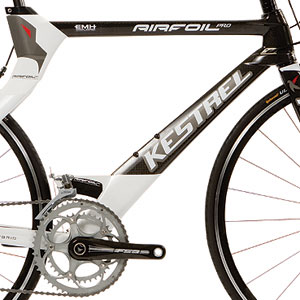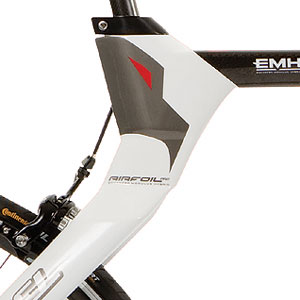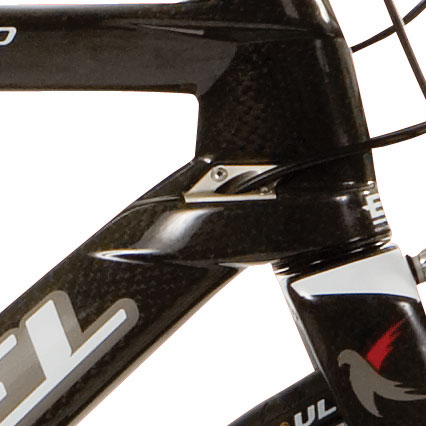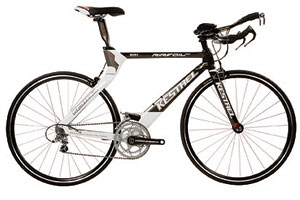Our verdict on the Kestrel Airfoil Pro?

When I acknowledge the challenge Advanced Sports, Inc. (Fuji American's legal corporate name) has in front of it I know whereof I speak. In 1997 I was running what was Saucony's bicycle division, which at that time consisted of the brand I founded, Quintana Roo. We took a hard look at Kestrel, which in retrospect has more or less been for sale for most of its two-decade existence. But the deal was not sweet enough for us. Instead we bought Merlin. Like Kestrel, Merlin was on unsound financial footing, but had a stellar brand image among its enthusiasts. Our goal was to place the brand on a sound financial platform while not losing the luster.
That's ASI's task with Kestrel. Fortunately (as was our case with Merlin), ASI has a strong product providing it a platform from which to work. This is not an example of a company simply buying a headbadge and no product. The Airfoil Pro is a serious bike for grown-ups.
The Airfoil Pro is like Cervelo's P3C, in that it is a model long in the tooth. Both these bikes were conceived, however, with a sufficiency thrusting them years in front of most in their competitive set. The Airfoil's molds have legs. The model still has some runway.
In its former iteration, owned by Sandpoint Design and headquartered in Monterey Bay, Kestrel advertised itself as “the first name in carbon,” a claim it rightfully made. These monocoque marvels were first introduced in the 1980s (it made the first all-carbon tri bike in 1990) and since then Kestrel has usually been at or near best in class in carbon bike design. Yes, Kestrel makes the Talon and, yes, this has been considered a tri-specific model in years past. But living in a garage doesn’t make you a car, and having only a Talon in your garage still means you’re without a tri geometry bike. Yes, Chris McCormack rode the Talon in triathlons and, yes, Tim DeBoom rode a Trek Madone in the Hawaiian Ironman. Neither are tri bikes. Both are good bikes. But they’re road bikes.
If it’s Kestrel and tri specificity you’re writing about, you can start and stop with the Airfoil Pro. This is a bike built to be ridden in the aero position, and that’s what makes this a tri bike — and a good tri bike it is. Kestrel’s tri-specific bikes were popular even when they were built in two sizes, and even when this company offered only a single size. The Airfoil Pro is built in 6 sizes, making it easy to find one that fits.

In fact, for any rider shorter than 5’8” its shorter head tubes are almost unique in triathlon. The Airfoil Pro’s 47 cm size, with a 76 millimeter head tube, is absolutely unique. There is no tri bike made offering a lower-to-the-ground fit for a rider under 5’4” tall. Keep in mind that this very tiny bike is also quite long. So, a rider will need to ride this bike steep. It's a wonderful choice for a 5'2" woman who rides at 80 degrees of seat angle. It's a less wonderful choice if that same woman rides at 76 degrees.
If you put on your industrial designer’s hat, the Airfoil Pro has got lines that make this frame just plain superior than just about anything else in cycling. Consider the homage (intentional or not) paid to the Airfoil Pro by this year's redesigned Orbea Ordu; if you get rid of the seat tube, the frame's lines appear similar to the Airfoil Pro even though the latter was designed years earlier. Inside the circumscription of industrial design the bike was years ahead of its time. But you have to take the designer's hat off in order to put on your bike helmet, so let’s look at it from a cyclist’s point of view.
The Airfoil Pro is seat-tubeless, which gives the bike a ride quality others can’t duplicate. Is it aerodynamically superior? Kestrel says so, and that includes the "old" Kestrel brass. Is it aerodynamic? I don’t know. But I do know that McCormack switched from the Talon to this model, based on his wind tunnel test results showing that the Airfoil Pro has geometry better suited to McCormack’s new, more tri specific, riding position (McCormack has since switched to Specialized and won his first Hawaiian Ironman while riding his Transition S Works).

Who ought to buy the $3500 complete Airfoil Pro, which is down $500 from last year yet still spec'd quite nicely? Pretty much the same sort of person who'd rightly consider a Felt, a Cervelo, or a QR. These bikes are all made to be ridden steep, because they're reasonably long. If you ride them shallow, you'll probably find them too long, and you'll be too stretched out, or you'll have to ride a very short stem.
Usually, this presents a problem for bikes made with shallow seat angles, because you want to ride the bike steep because that's how you ride, and because the bike's length asks for a steep position. But the shallow seat angle can present problems, since you're trying to get the bike steep but today's proprietary seat posts are not swappable with posts that'll get you into the position you want. In the Airfoil Pro's case, the bike uses a round seat post, so, no worries. Worst case, stick a Thompson dogleg set-forward seat post in the bike and it's problem solved.
Of course, this means the bike is outfitted with a round — these days unsexy — seat post. This you'll have to get past. Me, I don't think this affects the bike badly as to its utility. That established, I would not be surprised if the 09 version of this bike has an integrated aero post. I just hope it's a post that allows for forward saddle mobility.

I do have one geometric beef. Consider the old, very nice handling Airfoil (the first of what would eventually be made in two sizes). It had a front/center of 65cm (bottom bracket to front wheel axle). That was for its 56cm size. But this bike really rode "bigger." It fit me perfectly, and I'm 6'2". It really was functionally more like a 59cm bike. Now, the current Airfoil Pro in size 59cm has 63cm of front/center, and with 73.5 degrees of head angle. In our view the bike in this size would’ve been better with a head angle of, say, 72 degrees. This would’ve given the bike more front/center and, without changing the fork at all, would’ve had a more tri-typical 6cm or so of trail instead of its current 5.4cm in this size.
Still, this is a very nice bike, and I would be proud to ride it. I would enjoy riding it, because it would not only fit me nicely, the lack of that seat tube gives us oldsters (and you youngsters) a bit of compliance in the vertical plane that bikes these days, with their aero tubes, tend to lack.

